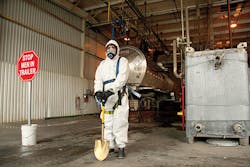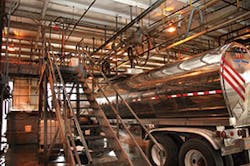Oilfield generates growing amount of business for DFW Tank Cleaning
OIL AND GAS shale drilling and production accounted for roughly 30% of the volume at DFW Tank Cleaning over the past several years. It is a trend that seems to be continuing into 2014.
Keeping up with the oilfield business is one reason the DFW Tank Cleaning facility in Waxahachie, Texas, has been expanded and upgraded. The commercial wash rack was expanded from five bays to six in 2010. More growth came in 2013 with the addition of a large new drivers’ lounge, a worker break room, another 2-1/2 acres of customer parking, and a secure hazardous waste/heel storage area.
“This is a busy tank wash facility, and we are already maxing out the additional capacity,” says Michael Cloonen, president of Coal City Cob Co Inc, sister company of DFW Tank Cleaning. I could see adding three to four more cleaning bays to keep up with demand. We’re already generating around 1,200 cleaning tickets a month, and we could go as high as 1,800.
“DFW Tank Cleaning has been far more successful than I ever expected. Our Waxahachie terminal (which includes DFW Tank Cleaning) looked like a major gamble when we opened it in 2007. We had $15 million on the line, and the US economy was headed off the cliff. We had to regroup, but by the last half of 2009, we started seeing improvement. Our operations have been growing since then.”
Hard work
A lot of hard work went into making the commercial tank cleaning operation a success. A big factor was the decision to focus on some of the toughest-to-clean products.
“We’ve built a niche cleaning some of the nastiest products carried in tank trailers,” says Joe Svehlak, facility manager at DFW Tank Cleaning. “Many of these jobs require us to send workers with non-sparking picks and shovels inside tanks to dig out built up product.
“Our workers do a great job, and they do it safely under some very difficult working conditions. It’s always wet. In addition, the tank interior is hot in the summer and cold in the winter. Workers often need to take a break after just 15 minutes inside the tank.”
Many of the tanktrailers that need to be hand-cleaned have transported oilfield chemicals, such as friction reducers or down-hole polymers used in fracking. Trailers hauling these products now account for as much as a third of the wash business at DFW Tank Cleaning.
Ground up guar beans are among the most difficult oilfield fracking materials to clean out, according to Svehlak. When there are heels, the ground guar beans will settle to the bottom of the tank in a mushy mess that must be removed through manual labor. It is a slimy work environment to say the least.
Cleanouts take a minimum of two to four hours. Workers suit up with Dupont Tyvek coveralls (usually two pairs of them), steel-toed rubber boots, bump cap, and full-face respirator with supplied air.
In addition to chemical trailers that have hauled oilfield products, the wash rack cleans crude trailers that have come in for maintenance. “Many of these trailers have been in the field for a long time, and it takes hand cleaning to remove built up sand and other muck,” Svehlak says.
Other oilfield equipment, including portable pumps and pump racks, come in for cleaning. “Some of these pieces of equipment take eight to 10 hours to clean,” Svehlak says. “Often, we’ll do these specialized cleanouts on weekends when operations are slower.”
Product variety
The mix of challenging products cleaned at the wash rack includes can liner produced by a local manufacturer. These cleanouts are performed in a dedicated wash bay that was modified for this type of product in 2009.
“We have to follow exacting customer requirements in cleaning these trailers,” Svehlak says. “Our customer requires the use of specific wash procedures and detergent. Once the tank is clean, we rinse with reverse osmosis-treated water. We have to leave about 30 gallons of reverse osmosis-treated water in the tank after cleaning, and the customer tests that water for contamination before loading the trailer with another shipment of can liner.”
Steady growth in chemical tank cleaning brought the addition of a sixth wash bay in 2010, expanding the building to 28,500 square feet. In all, the facility has nine work bays, including one isolated from the others and dedicated to foodgrade cleaning.
The foodgrade bay and the number one chemical wash bay are served by a 60-gallon-per-minute, 600-psi, single pass Peacock wash unit. The system can heat water to 210°F, and it has a dual-feed system for cleaning solutions. Spinners from Spraying Systems Inc are used with the Peacock unit. All piping is stainless steel.
Custom-built four-vat recirculating wash systems serve three of the four chemical bays, including the dedicated can liner bay. The vats contain hot and cold water, detergent, and caustic.
Each vat has its own Grundfos multi-stage vertical centrifugal pressure and return pumps. Wash operations are controlled by programmable logic controllers with soft starts and voltage protectors for the pumps.
Hot water
Chemical cleaning operations are served by an 200-horsepower boiler. Gammajet EZ-8 spinners are used with the vat system and run at 100 gallons per minute and 150 psi. Cleaning chemicals are from A-One Chemicals & Equipment Inc and Montgomery Manufacturing Company.
“The EZ-8 spinners have cut our chemical cleaning times, have a more efficient spray pattern, and require less maintenance,” Svehlak says. “In addition, they have a smaller diameter, which means they fit through smaller cleanout openings on trailers.
“Cleanouts on tank trailers remain important to us. I know some in the industry want to eliminate cleanouts, but we would have a very difficult time cleaning some products—like resins—without them. It would significantly raise cleaning costs.”
One bay is available for the cleaning of intermediate bulk containers. A Peacock single-pass wash unit runs Spraying Systems Inc spinners at 35 gallons per minute and 600 psi. It can deliver hot water at temperatures up to 210°F.
Passivation was added to the services offered by DFW Tank Cleaning in mid-2013 at customer request. “We have a portable system that includes a pump and spinner, and we use a passivation product from A-One,” Svehlak says. “We start with a hot water flush at 140°F. Next, we use the spinner to circulate the passivation chemical throughout the tank for eight to 10 minutes. Passivation helps prevent staining in stainless steel tanks, and it can prevent corrosion attacks by some products.”
Bay six at the wash rack contains most of the chemical/physical wastewater treatment system, including a dissolved-air floatation unit and a filter press to dewater waste solids. Also part of the treatment system are two 12,000-gallon flush tanks for water from the first rinse in the cleaning process and three 12,000-gallon equalization and aeration tanks. Treated water is released to a local treatment plant.
Vapors collected during the cleaning process are burned in a 40-ft-tall flare from Flare industries. It is a natural-gas fueled/air-assisted flare.
One of the newest additions to the facility is the fully enclosed and secured hazardous materials storage area. A metal roof helps keep the storage area dry. Items stored there include drummed heels.
Never closed
It takes a sizable staff to handle the wide variety of cleaning operations and safely operate the systems. A crew of nearly 50 workers keeps DFW Tank Cleaning up and running 24/7.
Members of the tank cleaning crew work 15 to 17 days a month with every other weekend being a three-day weekend. “It is helping us retain workers,” Svehlak says. “Another way we retain employees is by not rotating shifts. Tank cleaners work either days or nights.”
With the Texas economy running strong due to the still bustling oilfield and other factors, it can be tough to find new wash rack workers and keep them. DFW Tank Cleaning has turned to temp agencies for help in finding workers. In addition, the company will hire as young as 18 for summer jobs.
“We’re also working with a local junior college to develop programs that offer a career path,” Svehlak says. “We believe this could pay some good dividends.”
Because new hires come in with little or no tank cleaning experience, DFW Tank Cleaning trains them from the ground up. Training includes hands-on training and internet-based instruction.
“We’re using the internet-based training to cover a range of topics including confined space entry, forklift operation, hazardous materials requirements, and hazard communication requirements based on the Globally Harmonized System of Classification and Labeling of Chemicals,” says Neil Voorhees, vice-president of safety for Coal City Cob Company Inc. “These internet training modules include tests at the end to help ensure that our workers understand what they studied.”
Safety priority
Safety is a priority throughout the tank cleaning operation. “There are just too many ways people can get hurt in a wash rack, and we are working to make this the safest one in the industry,” Voorhees says. “Safety starts with having good processes in place.”
To that end, DFW Tank Cleaning achieved certification under the American Chemistry Council’s Responsible Care management System in 2013. “We went through that process to make sure we have standardized processes in place,” Voorhees says. “Improvements coming out of the RCMS process include adding more safety showers and eyewash stations on the wash bay mezzanines. We improved our confined space entry documentation for pre testing of sniffers.”
With all of the changes over the past several years, management believes DFW Tank Cleaning is well positioned for future growth and expansion opportunities. That might include cleaning of rail tankcars. ♦
About the Author
Charles Wilson
Charles E. Wilson spent 31 years covering the tank truck, tank container, and storage terminal industries throughout North, South, and Central America as the editor of Bulk Transporter. Prior to 1989, Wilson was managing editor of Bulk Transporter and Refrigerated Transporter and associate editor of Trailer/Body Builders. Before joining the three publications in Houston TX, he wrote for various food industry trade publications in other parts of the country. Wilson has a bachelor's degree in journalism from the University of Kansas and served three years in the U.S. Army.







